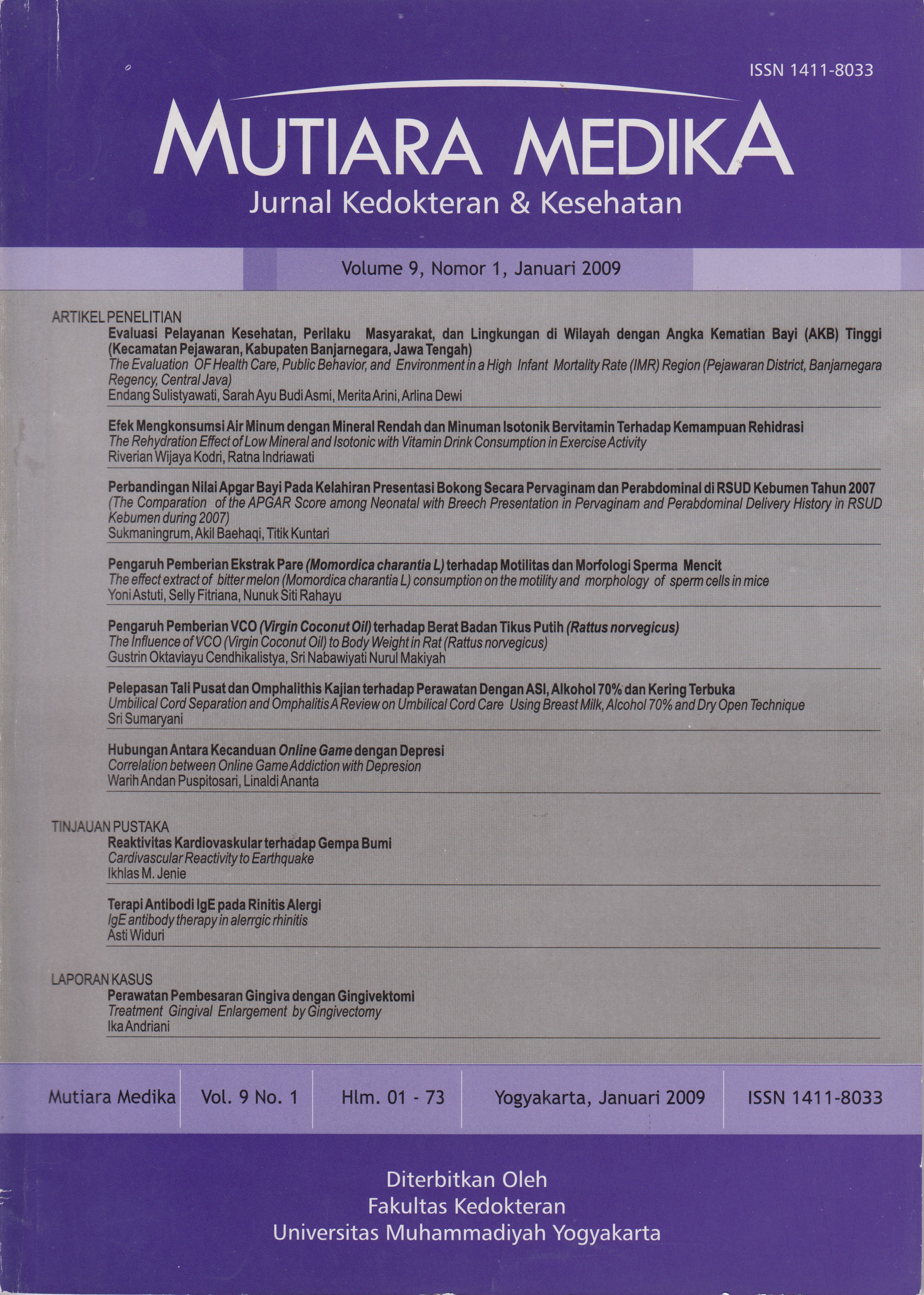Perbandingan Nilai APGAR Bayi Pada Kelahiran Presentasi Bokong Secara Pervaginam dan Perabdominal di RSUD Kebumen Tahun 2007
DOI:
https://doi.org/10.18196/mmjkk.v9i1.1587Keywords:
Nilai APGAR, Pervaginam, Presbo, Sectio secaria, APGAR score, Breech PresentationAbstract
Infant morbidity and mortality was higher in breech presentation than cephalic presentation. It is because of prematurity, asphyxia or trauma more often happening in breech presentation. Maternal morbidity rate was increased, which is caused of postpartum bleeding. The higher major caused of breech presentation perinatal mortality is asphyxia, which is can be identified by APGAR score. The objectives of this study are to compare the APGAR score among delivery history with breech presentation in pervaginam and perabdominal delivery. This research is a non experimental study using cross sectional study design. The subjects are patient with breech presentation and infant which is taking care in RSUD Kebumen during 2007. There is a significant infant APGAR score differences between pervaginam and perabdominal breech presentation delivery history (p value=0,00, IK95%). Infant APGAR score with breech presentation history wich is delivery by perabdominal is better than wich is delivery by pervaginam.
Angka kematian bayi sangat dipengaruhi oleh kematian perinatal. Pada presentasi bokong morbiditas dan mortalitas bayi lebih besar bila dibandingkan dengan presentasi letak kepala. Hal ini disebabkan karena pada presentasi bokong lebih sering terjadi prematuritas, asfiksia, atau trauma. Angka morbiditas ibu juga meningkat yang disebabkan oleh perdarahan pasca persalinan. Penyebab kematian perinatal pada presbo yang tertinggi umumnya adalah karena asfiksia, yang bisa diidentifikasikan dengan nilai APGAR. Penelitian ini bertujuan untuk mengetahui perbedaan nilai APGAR pada persalinan dengan riwayat presbo secara pervaginam dengan perabdominal. Penelitian ini merupakan rancangan penelitian cross sectional dan data diambil secara retrospektif dibagian rekam medis. Subjek penelitian berasal dari pasien dengan presbo dan bayinya yang dirawat di RSUD Kebumen selama tahun. Ada perbedaan yang bermakna antara nilai Apgar pada bayi riwayat persalinan presentasi bokong pervaginam dengan perabdominal (nilai p=0,00, IK95%). Nliai Apgar bayi dengan riwayat presbo yang dilahirkan secara perabdominal lebih baik dibandingkan dengan yang dilahirkan secara pervaginam.
References
Departemen kesehatan, 2004. Profil kesehatan Indonesia 2004. Depkes. Jakarta
Zupan, J., 2005, Perinatal Mortality in Developing Countries, NEJM, Volume 352:2047-2048.
Oxorn, Harry., Ilmu Kebidanan: Fisiologi dan Patologi Persalinan, edisi kedua, Yayasan Essentia Medica, Jakarta, 2003, hal. 195-231.
Bagazi, Umar F., Sofoewan, S., Siswosudarmo, R., 2002, Perbandingan Luaran Janin Presentasi Bokong Antara Persalinan Bracht dan Manual Aid. http//:www.obgin_ugm.com/ ?hal=articles_detail.php&no=21
Hofmeyr, 2006. The Management of Breech Presentation. Journal of Obstetricsad Gynecology. RCOG Guideline No. 20b
Matondang, S.C., Wahidayat, I., Sastrasmoro, S. 2003. Diagnosis Fisis pada Anak. Edisi 2, CV Sagung Seto. Jakarta.
Soedarto., 2000. Pemilihan Tehnik Persalinan Presentasi Bokong pada Kehamilan Aterm di RS DR. Sardjito. Lancet: 2000:356:1375-83
Wiknjosastro, H., 2000, Ilmu Bedah Kebidanan, edisi pertama, Yayasan Bina Pustaka Sarwono Prawirohardjo, Jakarta, hal. 104-122.
Wiknjosastro, H., 2000, Cesarean Section, History Development and Clinical Implications.http://alarm/ indonesia.net/id/1324511.htm
Cunningham, F.G., Gant, N.F., Leveno, K.J., 2001, Obstetri Williams (21st ed). Hartono, A., Suyono, YJ dan Pendit, B.U., 2004 (Alih Bahasa), EGC, Jakarta.
Amiruddin, R., 2007. Faktor Resiko Kejadian Partus Lama di RSIA Siti Fatimah Makasar Tahun 2006. http//www.ridwanamiruddin.wordpress.com
Jerneck, K.T., Herbst, A., 2001. Low 5- Minute Apgar Score: A Population- Based Register Study of 1 Million Term Births. Journal of Obstetrics and Gynecology. 98. 65-70.
Heija, A, A., Muhammed, A., 2001. Is Breech Presentation in Nuliparous Women at Term an Absolute Indication for Cesarean Section? Annuals of Saudi Medicine, Vol 21, Nos 3-4: 190¬192
Aji, P, 2005. Karakteristik Ibu dengan Persalinan Presentasi Bokong Berdasarkan Usia Ibu, Paritas, Umur Kehamilan, Cara Persalinan, Berat Badan Bayi Lahir, Apgar score, dan Faktor Penyulit Persalinan di Rumah Sakit Umum Kardinah Tegal. Karya Tulis Ilmiah. Fakultas Kedokteran Universitas Islam Indonesia. Yogyakarta.
Rudolph, M., Hoffman, E.J., Rudolph, D.C., 2006. Buku Ajar Pediatrik. Edisi 20. EGC. Jakarta.
Downloads
Published
Issue
Section
License
Copyright
Authors retain copyright and grant Mutiara Medika: Jurnal Kedokteran dan Kesehatan (MMJKK) the right of first publication with the work simultaneously licensed under an Attribution 4.0 International (CC BY 4.0) that allows others to remix, adapt and build upon the work with an acknowledgment of the work's authorship and of the initial publication in Mutiara Medika: Jurnal Kedokteran dan Kesehatan (MMJKK).
Authors are permitted to copy and redistribute the journal's published version of the work (e.g., post it to an institutional repository or publish it in a book), with an acknowledgment of its initial publication in Mutiara Medika: Jurnal Kedokteran dan Kesehatan (MMJKK).
License
Articles published in the Mutiara Medika: Jurnal Kedokteran dan Kesehatan (MMJKK) are licensed under an Attribution 4.0 International (CC BY 4.0) license. You are free to:
- Share — copy and redistribute the material in any medium or format.
- Adapt — remix, transform, and build upon the material for any purpose, even commercially.
This license is acceptable for Free Cultural Works. The licensor cannot revoke these freedoms as long as you follow the license terms. Under the following terms:
Attribution — You must give appropriate credit, provide a link to the license, and indicate if changes were made. You may do so in any reasonable manner, but not in any way that suggests the licensor endorses you or your use.
- No additional restrictions — You may not apply legal terms or technological measures that legally restrict others from doing anything the license permits.






